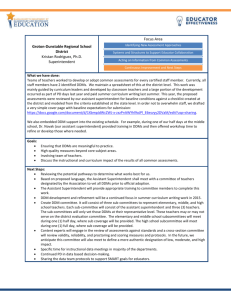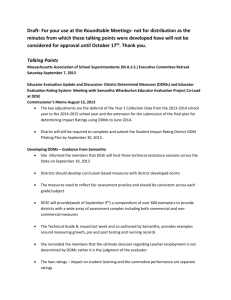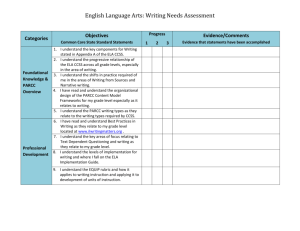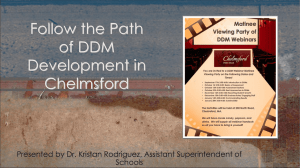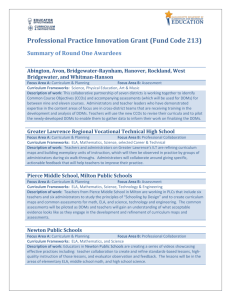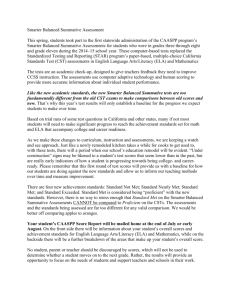DDM Leominster Saturday
advertisement
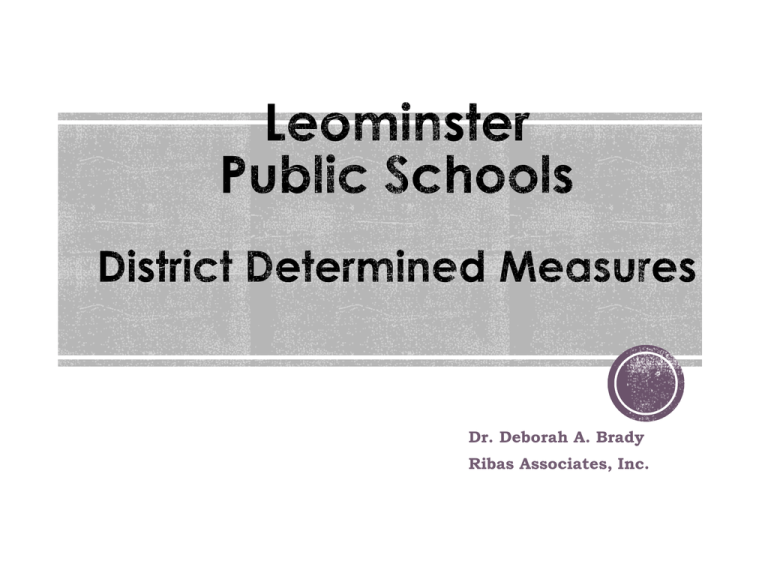
Dr. Deborah A. Brady Ribas Associates, Inc. First Hour Overview of District Determined Measures The Timeline Quality Assessments Tools from DESe Second Hour Job alike groups and departments work together Beth Pratt and Deb Brady will go from group to group Resources Rubrics Core Content Objectives Product: Facilitator hand in any unanswered questions or ??? By the end of the workshop, participants will: 1. Understand the quality expectations and assessment criteria for DDM assessments 2. Begin to draft a schedule for this year for your team or department 3. Begin the process of developing DDMs by (if there is time) Using the Quality Tracking Tool on at least one possible DDM Using the Educator Alignment tool to consider the local assessment needs 4. Email or send hardcopy of your group’s meeting minutes Include progress Remaining questions What you will need to be successful http://writingtotextbrady.wikispaces.com/Leominster+A ssessment+Workshop DESE Tools Quality Tracking Tool (Excel file) Educator Assessment Tool (Excel file) Core Curriculum Objectives (CCOs) Example Assessments (mainly commercial; some local) Model Curriculum Units with Rubrics (Curriculum Embedded Performance Assessments) Rubrics: Cognitive Rigor Matrices: Reading, Writing, Math, Science Research NY and NYC Achieve.org, PARCC, and many others SY 2014 SY 2015 SY 2016 • September: Pilot Plan for least 5 DDMs • December: Implementation Extension Request Form • Pilot 5 DDMs (at least) The scores do not count • June: Final Plan for assessing all teachers with at least 2 DDMs • Collect first year’s data on DDMs for all educators • Except waivered areas • Collect Data second year of data for all educators • Issue Student Impact Ratings for all except waived grades/courses/subjects • Pilot Year SY2014 SEPTEMBER DESE received B-R’s Plan for Early grade literacy (K-3) Early grade math (K-3) Middle grade math (5-8) High school “writing to text” (PARCC multiple texts) The scores will not count for PLUS one more non-tested course, for example: Fine Arts those who Music pilot DDMs in PE/Health 2014. Technology Media/Library Or other non-MCAS growth courses including grade 10 Math and ELA, Science DECEMBER: Implementation Extension Request Form for specific courses in the JUNE PLAN BY JUNE PLAN for all other DDMs must be ready for implementation in year 2 SY2015 At least one “local” (non-MCAS) and two measures per educator YEAR 2 SY 2015 All professional personnel will be assessed with 2 DDMs, at least one local: Guidance Principals, Assistant Principals Speech Therapists School Psychologists Nurses All teachers not yet assessed; general and special education The scores will count as the first half of the “impact score” The scores with the will count waivered as the first courses as the half of the only exception “impact score.” Year 3 SY2016 “Impact Ratings” will be given to all licensed educational personnel and sent to DESE Two measures for each educator At least one local measure for everyone Some educators will have two local measures Locally determined measures can include Galileo, DRA, MCAS-Alt The MCAS Growth Scores can be one measure The average of two years’ of scores And a two-year trend “Impact Ratings” Are based upon two years’ growth scores for two different assessments, one local. DESE is still rolling out the evaluation process and District Determined Measures 3 2 1 SY2013 Teacher Evaluation MA Model for all RTTT districts SY2014 Pilot DDMs for some courses (5) Due June Plan for DESE for all teachers. SY 2016 Use 2 years’ of SY 2015 Assess data from 2 all educators: assessments (at administrators, least one local) as specialists, all part of the teachers, evaluation guidance, school system, “impact psychologists, Ratings” Trends nurses Except Year 1 Except Waivered grades/subjects/ of Waivered grades/subject or courses /courses From the Commissioner: “Finally, let common sense prevail when considering the scope of your pilots. “I recommend that to the extent practicable, districts pilot each potential DDM in at least one class in each school in the district where the appropriate grade/subject or course is taught. “There is likely to be considerable educator interest in piloting potential DDMs in a no-stakes environment before year 1 data collection commences, so bear that in mind when determining scope.” Everyone earns two ratings Impact Rating on Student Performance Summative Performance Rating Exemplary Proficient Needs Improvement Unsatisfactory High Moderate Low *Most districts will not begin issuing Impact Massachusetts Department of Elementary and Secondary Education Ratings before the 2014-2015 school year. 11 Summative Rating Exemplary Proficient 1-yr SelfDirected Growth Plan 2-yr Self-Directed Growth Plan Needs Improvement Directed Growth Plan Unsatisfacto ry Improvement Plan Low Impact Rating on Student Performance Moderate High Rating of Impact on Student Learning Massachusetts Department of Elementary and Secondary Education 12 244/ 25 SGP 4503699 230/ 35 SGP 225/ 92 SGP Types Formats On Demand (timed and standardized) Mid-Year and End-of-Year exams Projects Portfolios Capstone Courses Unit tests Multiple choice Constructed response Performance (oral, written, acted out) MCAS Growth Scores can serve as one score for (ELA, Math 4-8; not 3, not HS) MCAS Growth Scores must be used when available, but all educators will have 2 different measures The MA Model Units Rubrics can be used (online for you) Galileo BERS-2 (Behavioral Rating Scales) DRA (Reading) Fountas and Pinnell Benchmark DIBELS (Fluency) MCAS-Alt MAP Why (beyond evaluation impact) determining these measures is important to every educator Assessment Quality Validity Reliability Rigor Scoring Guides Inter-rater reliability You will receive tools for these areas today Calibration of Scorers Developing assessment protocols Are all assessments of equally appropriate rigor K-12? Integrity of scores “Assessment creep” Training assessors Time Tabulating growth scores from student scores Organizing and storing scores Capitalize on what you are already doing Writing to text 9-12? K-12? Research K-12? Including Specialists? Art, Music, PE, Health present practices Math—one focus K-12? “Buy, borrow, or build your own” DESE Tools to assess Alignment Tools to assess Rigor Tools to assess the quality of student work Alignment Alignment to Common Core, PARCC, and the District Curriculum Shifts for Common Core have been made: Complex texts Multiple texts Argument, Info, Narrative Math Practices Depth over breadth Rigor Reliability Internal Consistency Test-retest Validity Are you measuring what Alternate forms/split half Inter-rater reliability 0 to 1 rating for Reliability None to 100% you intend to assess Content (=curriculum) Consequential Validity— good or bad impact Does this assessment narrow the curriculum? Relationships (to SAT, to grades) Correlation measurement -1 to +1 ratings Last First Grade Cours e DDM 1 DDM DDM 2 3 Smith Abby 1 ELA DRA F&P Smith Abby 1 Math Unit Test Galil eo Jones Bob 4 ELA MCAS Growth Unit Benchmark Galileo Jones Bob 4 Math MCAs Growth Unit Benchmark Galileo Adams John 9 ELA WTT Unit Adams John 10 ELA WTT Unit Adams John 11 Huma nities WTT Unit Cambr idge Anne Alg 1 Math WTT Unit Cambr Anne Geom Math WTT Unit Benchmark “Borrow, Buy, or Build” PRIORITY: Use Quality Tool to Assess Each Potential DDM to pilot this year for your school (one district final copy on a computer) CCOs will help if this is a District-Developed Tool If there is additional time, Use Educator Assessment Tool to begin to look at developing 2 assessments for all educators for next year Is the measure aligned to content? Does it assess what is most important for students to learn and be able to do? Does it assess what the educators intend to teach? (VALIDITY) 27 # Objective 1 Students analyze how specific details and events develop or advance a theme, characterization, or plot of a grade 9 literary text, and they support their analysis with strong and thorough textual evidence that includes inferences drawn from the text. 2 Students analyze how the structure, syntax, diction, and connotative or figurative meanings of words and phrases inform the central idea or theme of a grade 9 literary text, and they support their analysis with strong and thorough textual evidence that includes inferences drawn from the text. 3 Students analyze how specific details, concepts, or events interact to develop or advance a central idea of a grade 9 informational text, and they support their analysis with strong and thorough textual evidence that includes inferences drawn from the text. 4 Students analyze how cumulative word choice, rhetoric, syntax, diction, and the technical, connotative, or figurative meanings of words and phrases support the central idea or author’s purpose of a grade 9 informational text. 5 Students produce clear and coherent writing to craft an argument, in which the development, organization, and style are appropriate to their task, purpose, and audience, using such techniques as the following: introducing precise claim(s), distinguishing the claim(s) from alternate or opposing claims, and creating an organization that establishes clear relationships among claim(s), counterclaims, reasons, and evidence; developing claim(s) and counterclaims fairly, supplying evidence for each while pointing out the strengths and limitations of both in a manner that anticipates the audience’s knowledge level and concerns; using words, phrases, and clauses to link the major sections of the text, create cohesion, and clarify the relationships between claim(s) and reasons, between reasons and evidence, and between claim(s) and counterclaims; establishing and maintaining a formal style and objective tone while attending to the norms and conventions of the discipline in which they are writing; providing a concluding statement or section that follows from and supports the argument presented; and demonstrating command of the conventions of Standard English. ELA-Literacy — 9 English 9-12https://wested.app.box.com/s/pt3e203fcjfg9z8r02si Assessment Hudson High School Portfolio Assessment for English Language Arts and Social Studies Publisher Website/Sample Designed to be a measure of student growth over time in high school ELA and social science courses. Student selects work samples to include and uploads them to electronic site. Includes guiding questions for students and scoring criteria. Scoring rubric for portfolio that can be adapted for use in all high school ELA and social science courses. Generalized grading criteria for a portfolio. Could be aligned to a number of CCOs, depending on specification of assignments. Traditional Assessment Non-Traditional Assessment Administration/ Scoring Traditional End-of-Grade Assessment Pre/Post or Repeated Measures Paper/Pencil Traditional End-of-Course Assessment Performance Task Rubric Computer Supported Selected Response Portfolio or Work Sample Rubric Computer Adaptive Short Constructed Response Project-Based Rubric Machine Scored Writing Prompt/Essay Observation Rubric or Checklist Scored Locally Other: Scored Off-Site Buy, Borrow, Build Each sample DDM is evaluated Hudson’s Evaluation: Designed to be a measure of student growth over time in high school ELA and social science courses. Student selects work samples to include and uploads them to electronic site. Includes guiding questions for students and scoring criteria. Scoring rubric for portfolio that can be adapted for use in all high school ELA and social science courses. Generalized grading criteria for a portfolio. Could be aligned to a number of CCOs, depending on specification of assignments. Many are standardized assessments Is the measure informative? Do the results of the measure inform educators about curriculum, instruction, and practice? Does it provide valuable information to educators about their students? Does it provide valuable information to schools and districts about their educators? 31 Pre-Test/Post Test Repeated Measures (running records) Holistic Evaluation (portfolio) Post-Test Only (only when assessment lacks norm like AP use as baseline) 32 For Assessing Rigor and Alignment 1. Daggett’s Rigor/Relevance Scale 2. DESE’s Model Curriculum (Understanding by Design) 3. Curriculum Embedded Performance Assessments from MA Model Curriculum 4. PARCC’s Task Description 5. PARCC’s Rubrics for writing 1 Topic development: The writing and artwork identify the habitat and provide details Evidence and Content Accuracy: writing includes academic vocabulary and characteristics of the animal or habitat with details Artwork; identifies special characteristics of the animal or habitat, to an appropriate 2 3 Little topic/idea development, organization, and/or details Little or no awareness of audience and/or task Limited or weak topic/idea development, organization, and/or details Limited awareness of audience and/or task Rudimentary topic/idea development and/or organization Basic supporting details Simplistic language Little or no evidence is included and/or content is inaccurate Use of evidence and content is limited or weak Use of evidence and content is included but is basic and simplistic Artwork does not contribute to the content of the exhibit Artwork demonstrates a limited connection to the content (describing a habitat) Artwork is basically connected to the content and contributes to the overall understanding 4 5 6 Moderate topic/idea development and organization Adequate, relevant details Some variety in language Use of evidence and accurate content is relevant and adequate Full topic/idea development Logical organization Strong details Appropriate use of language Rich topic/idea development Careful and/or subtle organization Effective/rich use of language Use of evidence and accurate content is logical and appropriate A sophisticated selection of and inclusion of evidence and accurate content contribute to an outstanding submission Artwork is connected to the content of the exhibit and contributes to its quality Artwork contributes to the overall content of the exhibit and provides details Artwork adds greatly to the content of exhibit providing new insights or understandings New York State and New York City examples Portfolio (DESE Approved from Hudson PS) Connecticut: Specific tasks (Excellent for the Arts, Music) PARCC question and task prototypes http://www.parcconline.org/samples/ite m-task-prototypes Purpose Discuss possible assessments Consider what you need to accomplish this year using Schedule and Checklist Use Quality Tracking Tool on one assessment to understand how it supports your district, school, department Look at Educator Alignment tool to consider the “singletons” that may need to be addressed in your district, school, department Product Email or hard copy to Beth Pratt with minutes of your group’s meeting that may consider or be working on Assessments that you are working on Next steps What you need to be successful 1. Measure growth 2. Employ a common administration procedure 3. Use a common scoring process 4. Translate these assessments to an Impact Rating 5. Assure comparability of assessments (rigor, validity). 40
